Workshop 2: Becoming a Productive Leader
Catherine Dang; John Donald; and Technical Editor: Jack Miranda

LEARNING OBJECTIVES
This workshop will be continuing the development of the first domain as we want to ensure a solid foundation before continuing to develop the more outer domains. The main difference is last time we learned how to build a vision of the leader we want to be. Today’s goal is to become the most efficient and productive leader
Following this workshop students will be able to:
- Build and utilize a time management matrix
- Develop an approach creating sustainable habits
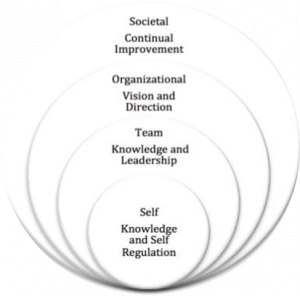
AGENDA
There will be split into three main concepts that you’ll find in this workshop. They include:
- Time management matrix
- Understanding the creation of habits
- The 4 laws of habit formation
TIME MANAGEMENT MATRIX
A time management matrix is sometimes referred to as an Eisenhower matrix. Powerful leaders such as President Eisenhower spoke about the effectiveness of this tool.
The Time Management Matrix
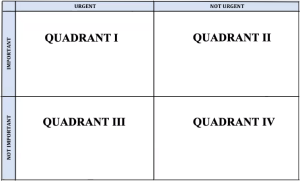
IMPORTANT VS URGENT
Important tasks have an outcome that leads us to achieve our goals. This doesn’t mean your boss’ or best friend’s goals, it’s your own personal goals. Urgent action demands your immediate attention. There exist more flexibility in this definition as some people’s “urgent tasks” may mean within the week whereas some people may think “urgent” is 24 hours. Everyone has different tolerances for urgency. Different activities can be urgent and important, one or the other and none at all.
WHY IS THE TIME MANAGEMENT IMPORTANT?
Having a matrix that divides everyday activities into classifications based on importance and urgency helps you be more proactive with your time than reactive. Being reactive while doing your actions becomes incredibly stressful if you are consistently trying to complete important tasks that are urgent. Being proactive helps us achieve our own goals in a more effective way.
The matrix focuses our time on meaningful productivity. Reflect if you have ever made a to-do list. Has it ever happened where you only spend time on the easiest things to get done so you can give yourself a checkmark? Then as you move towards completing all of the easy tasks you run out of time and energy to complete the important things of your day. The time matrix fixes this problem.
Here’s a full look at the time matrix. Let’s take a more in-depth look at each quadrant so you can understand how to make your own.
Quadrant 1 – Urgent and Important
Quadrant 1 is located on the top left of the matrix, intersecting with important and urgent. The action most associated with this quadrant is “DO”. Some examples you might see located in this quadrant are crises, pressing problems, and deadline-driven projects. It is critical that quadrant 1 is planned accordingly to avoid any stressful race against the deadline. You probably unknowingly heard this when your friends mention when they brag about how they pulled an all-nighter to finish studying for the midterm they have to do the next day. So if they always talk about it why isn’t this method the best way to achieve our goals
Try to keep this quadrant as clear as possible. The next quadrant will help us pull our tasks from not letting us be burnt out

Quadrant 2 – Not Urgent and Important
Quadrant 2 is the top right corner and displays important things that aren’t urgent. The action most associated with this quadrant is “PLAN”. Some examples include, planning, exercising, relationship building, and planned leisure activities.
As previously mentioned the best practice in quadrant one is to keep it balanced with quadrant 2. For example, if you exercise every day, you keep your health in check you don’t end up with a doctor appointment in quadrant 1. Or working on a relationship, if you neglect it, it will creep up in the form of an argument that will disrupt you for the rest of your day. Lastly, it could include reviewing your course notes every day as it will reduce the number of cram sections as midterms start to roll around. Productive leaders will spend most of this time on tasks located in this quadrant.
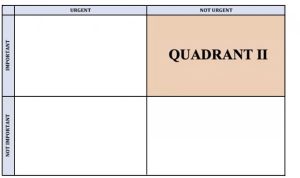
Quadrant 3 – Urgent and Not Important
Quadrant 3 is located in the bottom left of the matrix and could also be called “externally driven”, where you can control if they show up here. The action most associated with this quadrant is “ELMINATE”. You would have phone calls, meetings, and interruptions. Often this is usually where people ask you to do favors from up. It is important for them but not for you and often has a deadline, which makes it urgent. The best practice changing how you respond to their request. You can delegate it to someone else or just say no to the task. Additionally, try not to spend much time or effort as there is a task or to the importance of others, not your own goals.
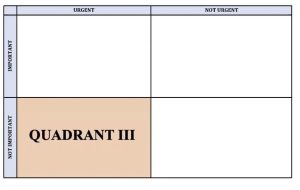
Quadrant 4 – Not Urgent and Not Important
Here you’ll find trial activities, distractive tasks, and impulsive pleasant activities. Or to put it bluntly, wasting your time. The best practice is to eliminate this. Think of this quadrant as a stop sign that gives you a heads up which points you in the direction of focussing the task on quadrant 1 or quadrant 2.
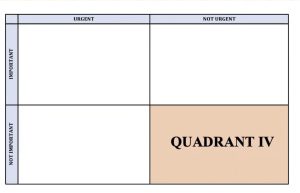
PUTTING IT ALL TOGETHER
So now that you know what every quadrant means in the time management matrix how can you use it effectively to achieve our goals?
- Do our tasks align with our goals? If they don’t resonate with your lifeview ask yourself why you are spending time that doesn’t attribute. You can’t always cross out every task that doesn’t align but it would be a red flag if all of your time will be spend not aligned with your core values
- Ensure that you can can make time for Quadrant 2, this usually includes decreasing action in both quadrant 3 and quadrant 4
Here’s a quick one-word graphic to easily show you how to follow the time matrix

ACTIVITY 1: CREATING YOUR TIME MATRIX
Fill out this worksheet where you create your own time matrix for the week. Try doing this sheet with a partner and see how your tasks are similar and different.
REFLECTION
- Where do you spend most of your time? What is your balance being proactive vs reactive?
- What can you do to manage the activities in the quadrant to eliminate activities from quadrants 3 &4?
BUILDING HABITS
If you find yourself spending too much time in quadrants 1,3 or 5, productive habits are a great tool to adjust your time matrix. To begin it’s important to learn about what is a habit. Habits are defined as practice tendencies, but let’s expand this simple explanation. In the book Atomic Habits1, James Clear mentions how
In other words, once your brain registered a habit, it sets you in a particular direction. Furthermore, it takes a lot of energy to eliminate the habit, good or bad.
WHY ARE HABITS IMPORTANT?
Whether you like it or not, habits shape our identity.
- They enable to translate our beliefs into everyday actions. You can think of it as demonstrating to others you do as you say.
- A lot of people identify themselves with their habits. For example, people describe themselves as being a smoker or a runner. With smoking and running being the habits.
- Another benefit is that habits reduce cognitive load and free up mental capacity. When you get so good at the habit you don’t have to think about it anymore and you can focus your energy that requires active problem solving
HOW DOES OUR BRAIN ENGAGE WITH HABITS
To understand how you can start to implement habits to become a productive leader, it’s important to understand how your brain forms habits in the first place. This habit-forming procedure is separated into a 4 parts feedback loop seen in the graphic below. By describing each part of the habit-building process, you will know where to apply them and why they work in the process.
The Four Stage of Forming a Habit
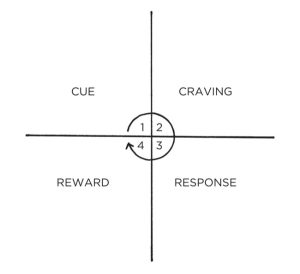
THE CUE
A cue triggers your brain to initiate a behavior that lets your brain know there might be something worth investing time in. This information is interesting to your brain because it predicts a reward. Your brain is always on the look for rewards which leads to step 2, the craving.
THE CRAVING
The craving is the motivation behind the habit. You don’t need to crave the habit itself, but the feeling it brings. For example, gamblers don’t enjoy the act of gambling but rather the joy and thrill it provides. As humans, our cravings are usually similar feelings while the triggers may be different.
THE RESPONSE
This is the habit itself. The probability of you performing the habit depends on two opposing forces where you debate which is greater; the fact that you have to put in the effort to do the habit or the need of satisfying the habit. The goal is to tip the scale to make sure the effort is minimized and the craving is maximized.
THE REWARD
This is the end goal and what the cue was looking for all along. Satisfy the craving but the important part is connecting the loop as your brain remembers this part the best. It learns if it continues to seek the cues then it will lead to the feeling of the reward. If the first three steps are making you do the habit, the reward is the key to making sure it happens repeatedly.
Clear, J. (2018). Atomic Habits. Random House
HOW TO CREATE HABITS
There are four laws that will ensure that each of the steps of the process is most likely to succeed and help to create effective and sustainable habits. This type of routine is helpful in the early stages of habit development and once it becomes engraved in your brain the four laws won’t be necessarily needed.
One important thing to keep in note is environmental design over motivation. Design your environment is much more impactful than pure motivation. Even if people can push through hard objectives using motivation alone, having these systems in place will help us during the day when you have little motivation
CUE. LAW 1: MAKE IT OBVIOUS
With this law, you want to design our environment with some sort of cue. Cues come in many forms:
- The most obvious and simple cue is visual. For example, If you want to start journaling, have all of the journalling materials on your bedstand or desk instead of being shoved away on a bookshelf.
- Another cue is implication intention. This is a written version of a cue that could be found on your agenda or desktop. This is a detailed plan outlined. It would look something like “I will do X at time Y in location Z”. This is an easy step but makes you take your habit seriously and shows you how it will fit into your daily life.
One last cue is called habit stacking. Habit stacking is a cue that comes from the reward of a previous habit. Start with stacking one new habit you want to integrate with a habit you already do daily. For example, if you were to brew coffee or tea in the mornings, instead of taking out your phone, do a two-minute medication as your wait for your coffee. Once you master the habit you might realize that another convenient habit is journaling. The reward of the meditation is feeling relaxed and that connects the loop back to stage one and that becomes a cue for you to start writing since you now feel relaxed
Once you master this you can start linking other habits. The main benefit of this cue is you don’t have to find a bunch of different times in your day if you want to integrate many different habits rather than see how they naturally flow into one another.
CRAVING. LAW 2: MAKE IT ATTRACTIVE
Remember that cravings are very powerful and you want to use that to your advantage. Design our environments to something important or enjoyable to us. This will naturally make it attractive.
- For something important, you have our values. Lining our habits by values is easy since our craving is rooted in something that is true to ourselves. You are less likely to give up on something that is true to your identity.
- Another method is by linking the habit with something you enjoy afterward. But you have to make a mental contract with yourself and agree to only do the enjoyable thing if you are committing to engaging with the habit. You would make no progress by only doing the activities you enjoy but disregarding the habit you want to make.
- You can also join a community that rewards your habits. If you want to get into a habit of working out, joining a class with friends would make it more attractive because you want to spend time with them.
RESPONSE. LAW 3: MAKE IT EASY
You want to design your environment to reduce friction. Friction can come in many forms but a common one is sheer magnitude.
First, downscale the habit if you need to. For example, if you want to work out 30 minutes a day start your first week by working out only 10 minutes every day then start to build up.
You can also address friction by reframing the problem by finding the decisive action. Decisive action is the milestone you reach in the response where you will follow through with the rest of the action. For exercise, the decisive action may not be the workout itself but the act of changing into the workout clothes. Putting on clothes is not that difficult but once you’re in them you would feel stupid changing back into regular clothes without exercising. Therefore, if the thought of working out is too intimidating, try doing your decisive action and the rest of the response will come naturally.
REWARD. LAW 4: MAKE IT SATISFYING
You want to design your environment for extrinsic rewards before intrinsic ones kick in. Remember the habit theory you want the reward to be very enjoyable so our brain remembers it as something very good. Intrinsic rewards should be this reward however at the start it might not be so clear so program in some temporary extrinsic reward to stand in until the intrinsic rewards manifest.
- To do this, tracking your progress is very satisfying, feeling proud of yourself for changing.
- You can enlist an accountability partner where you support each other for continuing the progress of your habits.
- You can also create a secondary reward system where after every response you can allocate an amount of dollar to save up for a gift for yourself
Clear, J. (2018). Atomic Habits. Random House
ACTIVITY 2: BUILDING HABITS
Fill out this worksheet to build the blueprints for creating your own habits. The first page is a provided example for you to understand how you can create your own habits and use the table.
Recall the list of values from workshop 1, you will be using it this workshop as well:
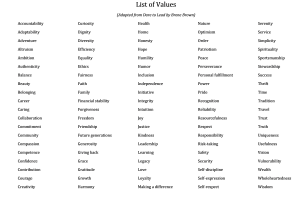
On the top of the page, there are two lines that say Identify and Habit. Your job is to pick a value from the list that means something to you and connect it to the habit, remember this helps us with the second law, make it attractive. If you complete the first workshop it doesn’t necessarily have to be your top three values, rather than values that you want to strengthen. Similar to activity one, try doing this sheet with a partner and see how your four steps are similar or different.
BARRIERS FOR CREATING EFFECTIVE HABITS
Now that you know how to create habits using the four laws there still exist some barriers for people trying to implement these four laws into their daily lives. Here are some common reasons why people can’t stick to their habits and how to overcome them:
UNDERPREPAREDNESS
This reason is already mitigated due to this workshop since you now know the science and proper procedure to create sustainable habits. However, ensure that you are doing the habit truly for your personal growth rather than chasing a trend or following a trend. This relates to the second law.
ACTIVATION ENERGY METAPHOR
The activation energy chart can be a metaphor of building a habit. In an endothermic reaction, a reaction that requires energy input, building a habit requires a lot of energy, you have to overcome the large activation energy hill in order to produce the products you want. For our habits, this is indicative of the energy it requires of you to start the habit. You want the formation to be a linear progression however, in reality, it is more of stored energy at the beginning but after you reach the top it takes a significantly less amount of energy to continue the habit. Expect the start to be hard!!
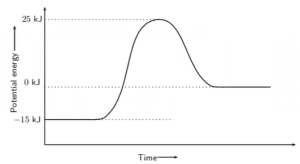
GOLDILOCKS ZONE
Based on popular psychology law call the Yerkes-Dodson law, it describes the range where humans reach peak motivation. From the fairy tale Goldilocks humans want things “just right” whether it be soup or mental challenges. Doing something too easy is a waste of time and gives you a false sense of employment and doing something too hard is not practical. Therefore breaking your habits into smaller steps is the best way to achieve your habit goals

WORKSHOP KEY TAKEAWAYS
In this workshop, you learned how to prioritize your schedule and how to build healthy and sustainable habits. You also how to lead ourselves and to set ourselves up for success, and the big theme was to think about long-term habits and planning and how their results won’t show up immediately. It’s until the habit become engraved in your brain that you start to reap the rewards and become a productive leader.
RESOURCES
Click here to access the workshop worksheets.

